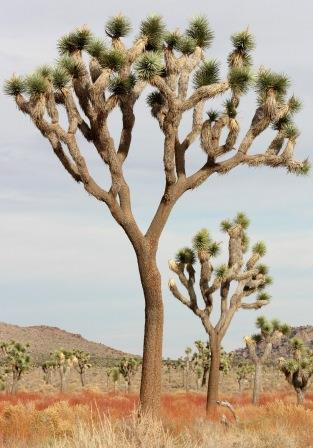The Joshua tree (Yucca brevifolia) is a remarkable evergreen, treelike plant found only in the southwestern United States. It was named by Mormon settlers in the early 1800s. Upon seeing the limbs of this plant branching upwards to heaven, the Mormon travelers were reminded of the biblical prophet Joshua, who raised his arms in prayer for guidance to the Promised Land. The Joshua tree is the largest member of the Yucca genus of monocotyledonous trees and shrubs, which is placed in the agave family (Agavaceae; order Asparagales) or the lily family (Liliaceae; order Liliales), depending on the taxonomic system being used for classification. The height of the Joshua tree can reach 15 to 40 feet (4.6 to 12.2 meters) and its diameter ranges from 1 to 3 feet (0.3 to 0.9 meters). Life spans of 150 to 200 years have been documented for this resilient species, with some unverified ages of 500 to 1000 years being estimated. See also: Asparagales; Liliales; Monocotyledons; Tree

The Joshua tree is the best known of the plants endemic to the Mojave Desert, which is the only place where it is found. (The Mojave Desert is predominantly in southeastern California, along with portions of Arizona, Nevada, and Utah.) Typically, it grows at elevations of 2000 to 6000 feet (610 to 1830 meters). It must survive the extremes of this desert habitat, including very arid and hot summers, freezing temperatures during winter nights, and little precipitation (most rainfall comes in the winter). See also: Mojave Desert
Because of the highly specific adaptations that allow the Joshua tree to survive in the Mojave Desert, it is often considered to be an indicator species for the health of that ecosystem. The key ecological relationship ensuring this plant’s survival is one of mutualism (a symbiotic interaction between two species that benefits both). Joshua trees, like most other yucca species, rely exclusively on the female yucca moth (genus Tegeticula) for pollination, and no other animal is capable of performing this action. As part of this unique relationship, the yucca moth has evolved special modified mouthparts enabling it to pollinate the flower of the Joshua tree, and the moth’s larvae feed solely on the plant’s seeds. Thus, the Joshua tree is incapable of reproducing without the moth’s pollination and the moth is dependent on the plant (specifically, its seeds) for the growth and development of its larvae. See also: Ecological communities; Ecology; Mutualism; Plant–animal interactions; Pollination; Seed; Symbiosis
Because of the limited range of the Joshua tree and its total reliance on the yucca moth for its reproductive success, the plant is quite vulnerable to dramatic changes in its environment. In particular, the effects of wildfires, droughts, and trends toward rising temperatures that have been attributed to global warming are predicted to be detrimental to the long-term survival of this species. See also: Climate modification; Drought; Endangered species; Forest fire; Global climate change; Global warming; Plant vulnerability to climate change





